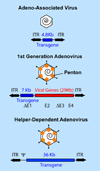Barriers for retinal gene therapy: separating fact from fiction
- PMID: 18565565
- PMCID: PMC2538423
- DOI: 10.1016/j.visres.2008.05.005
Barriers for retinal gene therapy: separating fact from fiction
Abstract
The majority of recent preclinical gene therapy studies targeting the retina have used adeno-associated virus (AAV) as the gene transfer vector. However, AAV has several limitations including the ability to generate innate inflammatory responses, the ability to cause insertional mutagenesis at a frequency of up to 56% in some tissues and a limited cloning capacity of 4.8Kb. Furthermore, AAV is known to generate limiting immune responses in humans despite the absence of similar immune responses in preclinical canine and murine studies. Three clinical trials to treat Leber's congenital amaurosis using AAV are under way. A clinical trial to treat Stargardt's using lentivirus vectors has also been recently announced. However, very limited evidence currently exists that lentivirus vectors can efficiently transduce photoreceptor cells. In contrast, very few preclinical ocular gene therapy studies have utilized adenovirus as the gene therapy vector. Nonetheless, the only two ocular gene therapy clinical trials performed to date have each used adenovirus as the vector and more significantly, in these published trials there has been no observed serious adverse event. These trials appear to be poised for Phase II/III status. Activation of cytotoxic T lymphocytes limits duration of transgene expression in the retina from first generation adenovirus vectors. However, an advanced class of adenovirus vectors referred to as Helper-dependent Adenovirus (Hd-Ad) have recently been shown to be capable of expressing transgenes in ocular tissues for more than one year. Hd-Ad vectors have many properties that potentially warrant their inclusion in the retinal gene therapy toolbox for the treatment of retinal degenerative diseases.
Figures

References
-
- Acland GM, Aguirre GD, Ray J, Zhang Q, Aleman TS, Cideciyan AV, Pearce-Kelling SE, Anand V, Zeng Y, Maguire AM, et al. Gene therapy restores vision in a canine model of childhood blindness. Nat Genet. 2001;28:92–95. - PubMed
-
- Acsadi G, Jani A, Massie B, Simoneau M, Holland P, Blaschuk K, Karpati G. A differential efficiency of adenovirus-mediated in vivo gene transfer into skeletal muscle cells of different maturity. HumMolGenet. 1994;3:579–584. - PubMed
-
- Akira S, Uematsu S, Takeuchi O. Pathogen recognition and innate immunity. Cell. 2006;124:783–801. - PubMed
-
- Ali RR, Reichel MB, Thrasher AJ, Levinsky RJ, Kinnon C, Kanuga N, Hunt DM, Bhattacharya SS. Gene transfer into the mouse retina mediated by an adeno-associated viral vector. Hum Mol Genet. 1996;5:591–594. - PubMed
-
- Ali RR, Sarra GM, Stephens C, Alwis MD, Bainbridge JW, Munro PM, Fauser S, Reichel MB, Kinnon C, Hunt DM, et al. Restoration of photoreceptor ultrastructure and function in retinal degeneration slow mice by gene therapy. Nat Genet. 2000;25:306–310. [see comments] - PubMed
Publication types
MeSH terms
Grants and funding
LinkOut - more resources
Full Text Sources
Other Literature Sources
Medical

